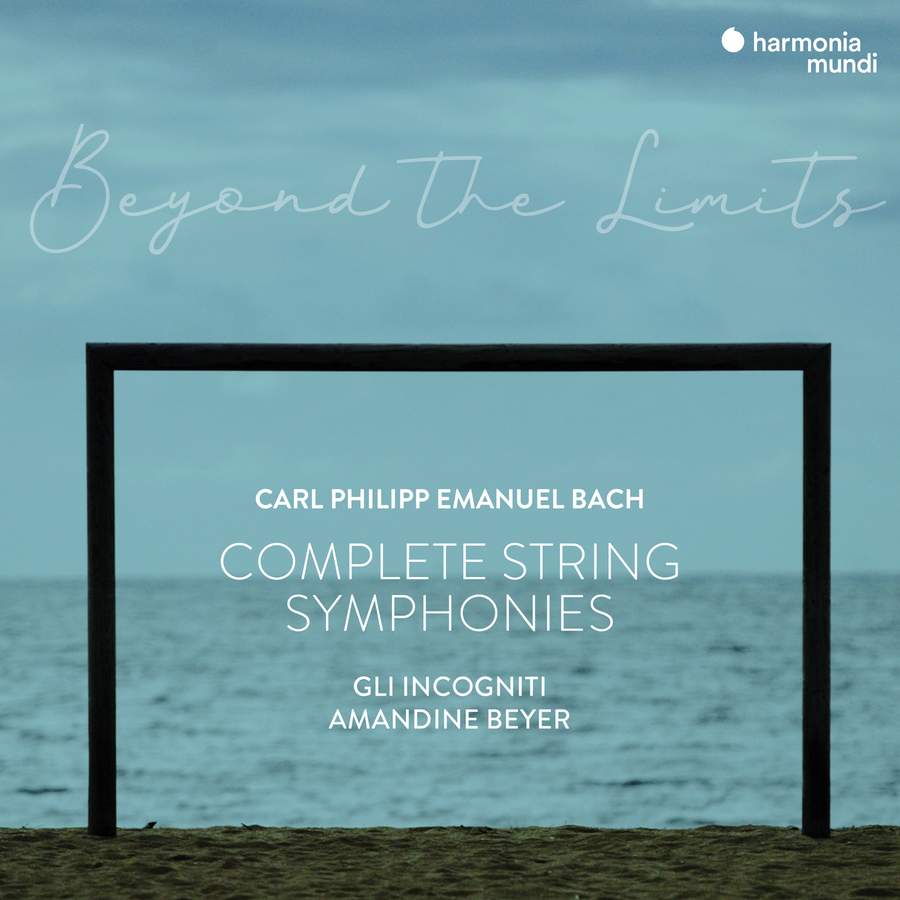
Amandine Beyer & Gli Incogniti – C.P.E. Bach: “Beyond the Limits” Complete Symphonies for Strings and Continuo (2021)
FLAC (tracks) 24 bit/96 kHz | Time – 01:11:02 minutes | 1,3 GB | Genre: Classical
Studio Masters, Official Digital Download | Digital Booklet, Front cover | © harmonia mundi
With these six symphonies dedicated to Baron van Swieten, Carl Philipp Emanuel Bach demonstrated his talent for instrumental and expressive genius. Entirely devoid of sentimentality and gratuitous extravagance, they open the doors to both Viennese Classicism and its immediate successor: Romanticism. It was only natural that, after tackling Haydn and the Esterházy princes, Amandine Beyer and Gli Incogniti should investigate this repertoire in which, once again, aristocratic patronage lies at the heart of musical creation.
“An artistic manifesto for the sovereign imagination of Carl Philipp Emanuel Bach” is how Gli Incogniti’s inspirational violinist-director Amandine Beyer and violone player Baldomero Barciela describe C. P. E. Bach’s six Hamburg symphonies in their forward to this programme recorded in the clean, softly supportive acoustic of Arras theatre; and that summation is spot on.
This was a set commissioned in 1773 by Baron van Swieten, an Austrian nobleman of Dutch decent who also financially supported Haydn and Beethoven. An unusually enlightened and musically curious character, Van Swieten accompanied this particular commission with the explicit specification that “no consideration of the difficulties that the performers might experience” should limit Bach’s imagination. In other words, in an era during which a composer mostly had to write to the tastes and technical skills of either their wealthy employer or the sheet-music-buying public, C. P. E. Bach was instead given artistic carte blanche to compose exactly the music in his head. The result was a startlingly, fiercely individual and stormy language over which both players and listeners are being thrown a fresh musical curveball every five seconds, whether that’s a new succession of extraordinary harmonic modulations, sudden pauses or changes of melodic direction, lightening-fast ensemble passagework, or close juxtaposition of strongly contrasting dynamics or styles. Who knows how the first performances sounded, because all of this would have stretched the ensemble technique and overall musical accomplishment of the day to its limits, and even today still constitutes a finger and brain-twisting challenge.
Not that it sounds as though Gli incogniti are being unduly stretched here. Au contraire, they’re tossing off even the most virtuosic moments of ensemble writing with cleanly articulated lightness, bounce and precision, with the sharp dynamic contrasts leaping out at you while never feeling uncomfortably exaggerated, and all with an infectiously joyous energy. It’s not just in the quicksilver passagework where they shine either. Listen in No. 4 in B minor to the way their central Larghetto ed innocentemente breathes, and its cleverly balanced tension between tender legato courtliness and sudden sombre, angular explosions. Or, if you want to admire both their tone and its capturing, head to the weighted silence of No. 2 in B-flat’s central slow movement, to hear the soft, plump roundness of the bass pizzicato sitting against the luminous violins. Further musicological interest comes from Beyer and her team having also thrown in the earlier Symphony in E minor, Wq. 177, which certainly sounds less adventurous than the Hamburg six, but also like an entirely different and wilder beast to Haydn’s “Sturm and Drang” symphonies which were being written at the same time – definitive proof that C. P. E. Bach was off on his own path right from the get-go.
One further point to make is that, while it’s probably fair to say that these intense works are generally best enjoyed just one or two at a time, the delicacy and vim of these readings make them stand up unusually well to listening from start to finish. © Charlotte Gardner
Tracklist:
1. Sinfonia in G Major, H. 657, Wq. 182/1: I. Allegro di molto (03:14)
2. Sinfonia in G Major, H. 657, Wq. 182/1: II. Poco adagio (03:16)
3. Sinfonia in G Major, H. 657, Wq. 182/1: III. Presto (03:43)
4. Sinfonia in E Major, H. 662, Wq. 182/6: I. Allegro di molto (02:08)
5. Sinfonia in E Major, H. 662, Wq. 182/6: II. Poco andante (02:50)
6. Sinfonia in E Major, H. 662, Wq. 182/6: III. Allegro spirituoso (03:36)
7. Sinfonia in B Minor, H. 661, Wq. 182/5: I. Allegretto (03:55)
8. Sinfonia in B Minor, H. 661, Wq. 182/5: II. Larghetto (02:28)
9. Sinfonia in B Minor, H. 661, Wq. 182/5: III. Presto (03:32)
10. Sinfonia in A Major, H. 660, Wq. 182/4: I. Allegro ma non troppo (04:14)
11. Sinfonia in A Major, H. 660, Wq. 182/4: II. Largo ed innocentemente (03:07)
12. Sinfonia in A Major, H. 660, Wq. 182/4: III. Allegro assai (04:07)
13. Sinfonia in C Major, H. 659, Wq. 182/3: I. Allegro assai (02:23)
14. Sinfonia in C Major, H. 659, Wq. 182/3: II. Adagio (02:45)
15. Sinfonia in C Major, H. 659, Wq. 182/3: III. Allegretto (04:53)
16. Sinfonia in E Minor, H. 652, Wq. 177: I. Allegro assai (03:49)
17. Sinfonia in E Minor, H. 652, Wq. 177: II. Andante moderato (03:06)
18. Sinfonia in E Minor, H. 652, Wq. 177: III. Allegro (03:24)
19. Sinfonia in B-Flat Major, H. 658, Wq. 182/2: I. Allegro di molto (03:07)
20. Sinfonia in B-Flat Major, H. 658, Wq. 182/2: II. Poco adagio (02:56)
21. Sinfonia in B-Flat Major, H. 658, Wq. 182/2: III. Presto (04:29)
Download:
mqs.link_AmandineBeyerGliinc0gnitiC.P.E.BachBey0ndtheLimitsC0mpleteSymph0niesf0rStringsandC0ntinu020212496.part1.rar
mqs.link_AmandineBeyerGliinc0gnitiC.P.E.BachBey0ndtheLimitsC0mpleteSymph0niesf0rStringsandC0ntinu020212496.part2.rar










![Amandine Beyer, Gli Incogniti - Biber: Mystery (Rosary) Sonatas (2023) [FLAC 24bit/96kHz] Amandine Beyer, Gli Incogniti - Biber: Mystery (Rosary) Sonatas (2023) [FLAC 24bit/96kHz]](https://imghd.xyz/images/2023/03/12/e84ho3-bibermyste-preview-m3.jpg)
![Amandine Beyer, Gli Incogniti - Vivaldi: "Il Mondo al rovescio" - Concerti con molti istromenti (2022) [FLAC 24bit/96kHz] Amandine Beyer, Gli Incogniti - Vivaldi: "Il Mondo al rovescio" - Concerti con molti istromenti (2022) [FLAC 24bit/96kHz]](https://imghd.xyz/images/2022/10/19/pe56mh2i5hzya_600.jpg)
![Michael Oman, Amandine Beyer, Austrian Baroque Company - London Calling (2020) [FLAC 24bit/44,1kHz] Michael Oman, Amandine Beyer, Austrian Baroque Company - London Calling (2020) [FLAC 24bit/44,1kHz]](https://getimg.link/images/imgimgimg/uploads/2020/09/YJsK0qA.jpg)
![Gli Incogniti & Amandine Beyer - BWV… or not ? (2017) [Qobuz FLAC 24bit/88,2kHz] Gli Incogniti & Amandine Beyer - BWV… or not ? (2017) [Qobuz FLAC 24bit/88,2kHz]](https://getimg.link/images/imgimgimg/uploads/2018/07/SmGWTcv.jpg)
![Gli Incogniti & Amandine Beyer - Vivaldi: The Four Seasons, Op. 8 & Other Concertos (2008/2015) [FLAC 24bit/96kHz] Gli Incogniti & Amandine Beyer - Vivaldi: The Four Seasons, Op. 8 & Other Concertos (2008/2015) [FLAC 24bit/96kHz]](https://getimg.link/images/imgimgimg/uploads/2019/11/RoYRfnN.jpg)
![Amandine Beyer, Leila Schayegh - Caldara: Trio Sonatas (2015) [FLAC 24bit/96kHz] Amandine Beyer, Leila Schayegh - Caldara: Trio Sonatas (2015) [FLAC 24bit/96kHz]](https://getimg.link/images/imgimgimg/uploads/2018/08/kFzAl4v.jpg)